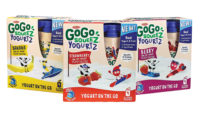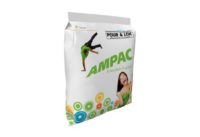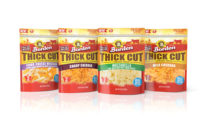Flexible packaging is living up to its name. As convenience and sustainability become increasingly important to consumers, packaging suppliers are responding with more malleable designs.
Indeed, newer resealable, portable and smaller-size packaging is becoming more prominent, as are options that feature eco-friendly materials.
“Manufacturers continue to accelerate their adoption of flexible packaging designs for on-the-go packaging and recloseability,” states the Reston, Va.-based Association for Packaging and Processing Technologies (PMMI) in its “Flexible Packaging Assessment 2019” report. “Sustainability also continues to be a major focus, with manufacturers using compostable and biodegradable films to meet industry demands.”
Convenience features include snap-to-seal tops and press-to-close zippers on flexible bags for such items as sour cream and shredded cheese, the report notes. Pouches account for the majority of flexible packaging, PMMI states, with increasing demand for ready-to-eat foods in lighter-weight and easy-to-carry containers driving popularity.
Indeed, PMMI notes that advances in pouch characteristics such as closures and spouts, along with technologies that increase processing line speeds, will continue to lower production costs and make pouches more competitive with other forms of packaging, including cartons and cans.
Yet while plastic pouches remain dominant, paper-based dairy packaging use also is steadily expanding as interest in sustainability becomes more widespread, says Jorge Izquierdo, PMMI’s vice president of market development.
“Competition in the dairy space is very tough, so many brand owners are working to differentiate their products with packaging,” he states, “using biodegradable materials to present themselves as environmentally friendly.”
An evolving packaging landscape
In addition, the availability of more dairy selections is resulting in the expansion of flexible packaging applications, says Alison Keane, president and CEO of the
Annapolis, Md.-based Flexible Packaging Association.
She notes, for instance, that along with hanging and flat resealable pouches that support a variety of cheeses, you’ll find pouches for liquids and semi-liquids, including yogurt and sour cream. Such packages can stand up on caps to keep product from sticking to the bottom of containers and preventing the first squeeze from being watery.
“Pouches have the advantages of portability and taking up less space than their packaging alternatives,” Keane states. “The novelty to consumers is helping to fuel popularity.”
Packaging that enables dairy products to stay fresher and tastier longer while reducing food waste also is becoming more prominent, says Rebecca Casey, senior vice president, marketing and strategy at TC Transcontinental Packaging, a Chicago-based supplier of flexible packaging materials.
Options include simple-to-use resealable lidding that makes secondary packaging unnecessary and gives more brand presence in consumers’ refrigerators, and packaging that supports grab and go and portion control applications, she states.
“Such packaging is a great way for cheesemakers to differentiate themselves at the point of purchase,” Casey says.
The need to prevent foods from decaying too quickly, meanwhile, is leading flexible packaging developers to focus on protection and barriers, says Bryn Rabtor, technical director, primary packaging, for Berry Global, an Evansville, Ind.-based packaging and materials supplier.
“The packaging needs to be strong enough to withstand the rigors of cold manufacturing environments and potentially rough handling,” he says, noting that many film designs are incorporating high oxygen barrier materials to extend shelf life by preventing the permeation of oxygen.
Rabtor adds that greater use of metallocene resins in films is enabling operators to provide stronger seals at lower costs.
Don’t go solo
It is crucial, however, that dairy processors work closely with their technology and film providers in determining the most effective packaging for their specific product lines and operations, analysts note.
“With many variations of flexible packaging, it is important that processors know what to expect in machine performance when incorporating newer materials before making film changes,” Izquierdo says. “Processors should join with the original equipment manufacturers and materials suppliers and not try to do things alone. Planning ahead before switching materials, rather than just seeing what happens when they leverage new films, is crucial.”
Rabtor agrees, stating that “there is a lot of downstream expertise that can be brought to bear. Greater communication between dairy processors and their packaging suppliers, including film or resin manufacturers, will ensure that processors’ needs are being met.”
Operators considering a change in materials should test the films on the appropriate packaging technologies before making major alterations to their processes, adds Christian Uebele, product market manager — thermoformers, for Multivac, a Kansas City, Mo.-based packaging machine developer.
Selecting the optimal flexible packaging is vital, as incorporating inadequate materials can have severe consequences, Casey says. Ramifications might include leaky containers and eventually moldy products; loss of efficiencies on the filling lines or converting operations; a decrease in shelf presence, leading to fewer sales and lower brand equality; and an overall lower quality package, she notes.
“Substandard films can create a litany of issues, ranging from poor seal integrity to poor barrier properties,” Uebele adds. “Film that is too thin for the draw ratio will not form well, and the barrier layer may become too thin and lose its integrity, diminishing effectiveness throughout the distribution chain and causing a shorter product shelf life.”
Indeed, using packaging that doesn’t meet barrier or strength requirements can be “catastrophic” in terms of product loss and potential harm to public health because of the perishable nature of products, Rabtor states.
“Specifications and industry organizations can help drive uniformity and limit this concern,” he says.
A boost for biodegradability
Sustainability, meanwhile, is perhaps the major catalyst in the launch of newer flexible packaging designs. Casey, for instance, says TC Transcontinental is receiving more inquiries for packaging that uses biodegradable materials and is compatible with store drop-off recycling programs.
She notes, however, that a widespread rollout of recyclable products “has not been swift” due to hurdles with maintaining high-speed efficiencies in packaging operations. TC Transcontinental is focusing on the development of film technologies and coatings to solve the issue while making current selections more eco-friendly.
“Sustainability will drive the entire flexible packaging industry, including the dairy market,” Casey says. “For us, that means supporting a circular economy where all players from sourcing, manufacturing and end-of-life management are involved and accountable to create sustainable packaging, and working directly with dairy processors to achieve the proper infrastructure for a circular economy.”
Processors, however, might need to upgrade their machinery or resolve to operate lines at slower speeds when converting to more eco-friendly films, Izquierdo says.
“You cannot run biodegradable films as fast as traditional films,” he states, noting that pressure differences can slow the time it takes to seal products.
“Suppliers in recent years have been optimizing materials to run as fast as possible on equipment, but new films with new substrates, such as those that are biodegradable, are not necessarily designed to run fast,” he states. “It is a trade-off.”
Dairy processors that retrofit machinery to support different sealing components might need to move from thermal to ultrasonic sealing and materials to maintain productivity, Izquierdo says.
“But the first approach is to try to optimize the equipment to run with new materials before investing in retrofits,” he states. “Sometimes processors simply have to make adjustments to the controls so that the technology operates more precisely.”
He adds that incorporating biodegradable materials can alter the dynamics of the entire production operation.
“It goes beyond the higher expense of the packaging itself to the loss of productivity on the packaging line,” Izquierdo states. “Processors need to make sure that the profit they are getting from products will pay for these costs.”
Yet eco-friendly flexible packaging might soon become a necessity, as laws are under consideration that will tax processors on the amount of resin in their packaging and the quantity of packaging waste, Uebele notes. He says Multivac is working with material suppliers to develop sustainable packaging substrates for use on Multivac packaging equipment.
“By combining the oxygen barrier properties of plastic with the supporting structure of card stock or corrugated paper, it is possible to have an environmentally friendly package which attractively displays the product on a rigid formable paper card and protects it with a thin layer of plastic,” Uebele states. “When separated, the thin plastic generates less waste in landfills, and the rigid paper can be recycled or possibly composted.”
A wide array of options
He notes that technology suppliers are developing a wider range of machinery to support the greater variety of films and packaging formats. That includes standard flexible film vacuum packages for common blocks of cheese and shingled cheese; peel-reseal films and press-to-close and slider zippers for gas-flushed shredded and cubed cheese that processors often package in larger quantities; vacuum skin packaging for form-fitting film that drapes tightly over products; and film that shrinks after packaging to produce a tight wrinkle-free flexible skin on all sides of the product.
“Films are playing a large part in the development of packaging equipment,” Uebele says, noting that machines also are evolving to accommodate an increase in film capabilities. He states that Multivac is working with material suppliers and dairy processors to create and test films for specific applications on a variety of packaging machines.
By using the most appropriate flexible packaging and films, dairy processors will be in strong position to protect products, increase shelf life and create a “beautiful package which promotes quality and value,” Uebele notes.
Proper premade pouches also will enable processors to reduce carbon footprints and appeal to the most sustainable-minded consumers, including millennials and Generation Z, says Al Madonna, vice president of marketing for Cheer Pack North America, a West Bridgewater, Mass.-based manufacturer of spouted pouches for yogurt and other foods.
He notes that Cheer Pack and many other film and converter suppliers are “working actively on the end-of-life opportunity as part of the circular economy,”
But because the dairy industry has a variety of highly fragmented markets, many smaller processors might not be aware of new packaging innovations, Rabtor says.
“Having the processors work together in cooperatives, with industry organizations and their suppliers to maximize communication and knowledge of packaging options will yield dividends,” he states.







